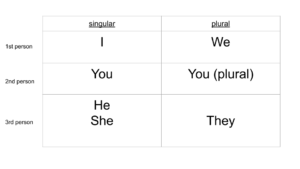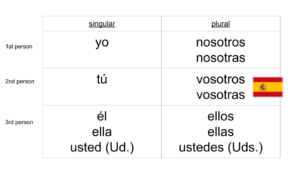 Let’s talk about subjective personal pronouns. This is really one of the foundations for learning correct Spanish grammar. So take your time with this and make sure you understand it. Subjective personal pronouns (or subject pronouns) are used when the pronoun is acting as the subject of the verb in the sentence. For example, instead of saying “The boy caught the ball” we can use a subjective personal pronoun and say “He caught the ball”. In Spanish, and in several other languages these are the basis of verb conjugation which is how the verb changes to show the person, number, or tense of the subject. That’s a fancy way of saying using the correct form of the verb. In English, we usually only have a couple of different “forms” or conjugations of the verbs, but that is not the case in many other languages.
Let’s talk about subjective personal pronouns. This is really one of the foundations for learning correct Spanish grammar. So take your time with this and make sure you understand it. Subjective personal pronouns (or subject pronouns) are used when the pronoun is acting as the subject of the verb in the sentence. For example, instead of saying “The boy caught the ball” we can use a subjective personal pronoun and say “He caught the ball”. In Spanish, and in several other languages these are the basis of verb conjugation which is how the verb changes to show the person, number, or tense of the subject. That’s a fancy way of saying using the correct form of the verb. In English, we usually only have a couple of different “forms” or conjugations of the verbs, but that is not the case in many other languages.
To begin, let’s look at the subjective personal pronouns in English. This is one of the grammar topics that you use every day, but you may not know all the “rules” and “details” or proper names. When you are learning a language, you will in turn learn the names and rules of many of the grammar concepts in your native language as well. Here are the subjective personal pronouns in English:

Here are the subjective personal pronouns in Spanish:

Note that there is no form of “it” as a subject pronoun in Spanish. Also, “you” works a little different in Spanish. Please watch the video for a better explanation and help with pronunciation.




